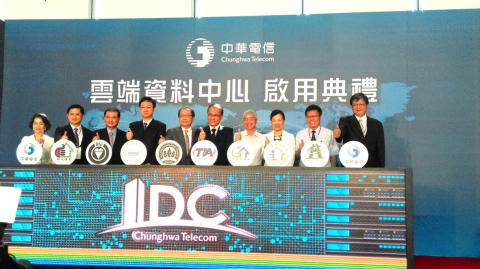Chunghwa Telecom Co (CHT, 中華電信), the nation’s biggest telecom operator, yesterday launched its new cloud computing data center in a bid to accelerate the nation’s digital economy and industry transformation.
“We aim to elevate Taiwan to one of the leading data hubs in Asia and attract international businesses, such as over-the-top content providers, as well as boosting the nation’s financial technology development,” chairman Rick Tsai (蔡力行) said at the facility’s opening ceremony in New Taipei City’s Banciao District (板橋).
The international data corp facility covers 90,000m2, has 4,500 server racks and cost NT$13 billion (US$407 million) to build, the company said.

Photo: Ho Yu-hua, Taipei Times
The complex is adjacent to the Taiwan Stock Exchange and the Taiwan Futures Exchange data facilities to achieve low latency for financial-sector clients, the company said, adding that it provides virtual private network solutions to more than 80 percent of local brokerages.
On Thursday, the company told an investors’ conference that its capital expenditure in the first half fell 34.6 percent annually to NT$6.8 billion, meeting only 22 percent of its goal for this year.
“Our expenditure target this year remains unchanged at NT$30.6 billion,” Tsai told reporters yesterday, adding that the dip in the first half was due to slower-than-expected progress in a number of construction projects.
“Construction and spending will accelerate in the second half, meeting the target for this year,” Tsai said.
Credit Suisse Group AG analyst Varun Ahuja said in a note that the company’s capital expenditure is expected to increase in the second half, mainly on new submarine cable and other information and communications technology-related projects.
Tsai yesterday reiterated the company’s goal to add 2 million 4G mobile subscribers before the end of this year and bolster its 37.5 percent market share.
The company’s enterprise solution sales are expected to grow from 4 to 5 percent of the company’s total revenue last year to between 6 and 8 percent, helped by the new facility and expanded capacity, Chunghwa Telecom president Shih Mu-piao (石木標) said on Thursday.
However, Shih said enterprise solution sales have much lower margins compared with the company’s consumer telecoms services.
Meanwhile, the company is facing slowing growth in higher-tier subscription counts, as Taiwan’s 4G penetration has reached 50 percent.
“Most higher-tier subscribers have already upgraded to 4G and future growth will rely on lower-tier 2G and 3G holdouts,” Shih said.
At the same time, rising competition from rival carriers in the lower-tier segments, as well as SIM card consolidation among subscribers have strained the company’s average revenue per user performance, he said.
Shih said that it would take considerable time before consumers adjust to the company’s new pricing structure, which was launched in April, and that the company is not expecting tangible improvements in earnings from its new NT$999 and NT$1,399 data plans in the near term.
Consumers prefer unlimited or generous data plans to high handset purchase subsidies, Shih said, adding that the current iPhone model is not as popular as its predecessors, leading to diminished demand.

The New Taiwan dollar is on the verge of overtaking the yuan as Asia’s best carry-trade target given its lower risk of interest-rate and currency volatility. A strategy of borrowing the New Taiwan dollar to invest in higher-yielding alternatives has generated the second-highest return over the past month among Asian currencies behind the yuan, based on the Sharpe ratio that measures risk-adjusted relative returns. The New Taiwan dollar may soon replace its Chinese peer as the region’s favored carry trade tool, analysts say, citing Beijing’s efforts to support the yuan that can create wild swings in borrowing costs. In contrast,

Nvidia Corp’s demand for advanced packaging from Taiwan Semiconductor Manufacturing Co (TSMC, 台積電) remains strong though the kind of technology it needs is changing, Nvidia CEO Jensen Huang (黃仁勳) said yesterday, after he was asked whether the company was cutting orders. Nvidia’s most advanced artificial intelligence (AI) chip, Blackwell, consists of multiple chips glued together using a complex chip-on-wafer-on-substrate (CoWoS) advanced packaging technology offered by TSMC, Nvidia’s main contract chipmaker. “As we move into Blackwell, we will use largely CoWoS-L. Of course, we’re still manufacturing Hopper, and Hopper will use CowoS-S. We will also transition the CoWoS-S capacity to CoWos-L,” Huang said

Nvidia Corp CEO Jensen Huang (黃仁勳) is expected to miss the inauguration of US president-elect Donald Trump on Monday, bucking a trend among high-profile US technology leaders. Huang is visiting East Asia this week, as he typically does around the time of the Lunar New Year, a person familiar with the situation said. He has never previously attended a US presidential inauguration, said the person, who asked not to be identified, because the plans have not been announced. That makes Nvidia an exception among the most valuable technology companies, most of which are sending cofounders or CEOs to the event. That includes

INDUSTRY LEADER: TSMC aims to continue outperforming the industry’s growth and makes 2025 another strong growth year, chairman and CEO C.C. Wei says Taiwan Semiconductor Manufacturing Co (TSMC, 台積電), a major chip supplier to Nvidia Corp and Apple Inc, yesterday said it aims to grow revenue by about 25 percent this year, driven by robust demand for artificial intelligence (AI) chips. That means TSMC would continue to outpace the foundry industry’s 10 percent annual growth this year based on the chipmaker’s estimate. The chipmaker expects revenue from AI-related chips to double this year, extending a three-fold increase last year. The growth would quicken over the next five years at a compound annual growth rate of 45 percent, fueled by strong demand for the high-performance computing